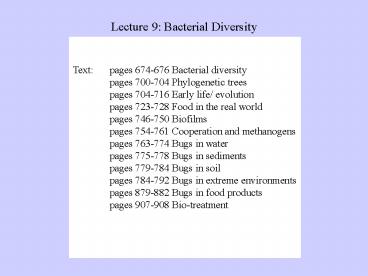Lecture 9: Bacterial Diversity - PowerPoint PPT Presentation
1 / 19
Title:
Lecture 9: Bacterial Diversity
Description:
Text: pages 674-676 Bacterial diversity. pages 700-704 Phylogenetic trees ... Smoker/hot vent ~15x106 yr cycle 'tube worms' ecosystem ... – PowerPoint PPT presentation
Number of Views:201
Avg rating:3.0/5.0
Title: Lecture 9: Bacterial Diversity
1
Lecture 9 Bacterial Diversity
Reading assignments in Text Lengeler et al.
1999 Text pages 674-676 Bacterial
diversity pages 700-704 Phylogenetic
trees pages 704-716 Early life/ evolution pages
723-728 Food in the real world pages 746-750
Biofilms pages 754-761 Cooperation and
methanogens pages 763-774 Bugs in water pages
775-778 Bugs in sediments pages 779-784 Bugs in
soil pages 784-792 Bugs in extreme
environments pages 879-882 Bugs in food
products pages 907-908 Bio-treatment Lecture
8 Text pages 586-601 Sporulation pages 627
Secondary metabolism
2
Lecture Overview
Bacterial populations (lab conditions)
Bacteria as single cells (cell cycles)
Differentiation
Symbiosis
Sporulation
Bacterial Environments and Diversity
3
Deep-sea symbiosis between lithotrophs and
eukaryotes
4
(No Transcript)
5
Epulopiscium fishelsonii (the big one)
250 microns
6
Molecular 16S rRNA phylogenic analysis
Value?
Any organism, even non-culturable
7
(No Transcript)
8
The 16S rRNA Tree of Life
9
(No Transcript)
10
Archaea versus Bacteria (are they really
different?)
Yes
No
X
Cell division
Biosynthesis, amino acids, etc.
X
X
Signaling, Chemotaxis
Polymerization
11
(No Transcript)
12
Bacterial numbers and distributions
(from Whitman et al. 1998 PNAS 956578.)
Total 4-6 x 1030 cells
Water 12 x 1028 cells
Sediments 355 x 1028 cells
Biofilms
Soil 26 x 1028 cells
People 6 x 109 4 x 1023 colon
Cows 1 x 109 29 x 1023 rumen
Deep earth 25-250 x 1028 cells
Termites 2 x 1017 7 x 1023 gut
Air 5 x 1019 cells
Growth / Turnover in Days (not DT)
Water shallow 16
Sediments 500,000
Water deep 300
Soil 900
Phototrophs 1.5
Animals 1
13
(No Transcript)
14
adhesion threads
Deinococcus geothermalis This pink-pigmented
bacterium often forms biofilms. This electron
micrograph shows cells attached on polished
stainless steel in sterilized paper machine water
at 45C.
15
Biofilm spread
4 mm
Actinobacillus actinomycetemcomitans
(stained with crystal violet) Biofilm colony on
polystyrene petri dish Releases cells to form new
colonies
16
Natural bacterial distributions
Imprint of a clover leaf on a methanol mineral
salts plate incubated at 30C for 2 days to allow
outgrowth of the pink-pigmented Methylobacterium
strains.
17
(No Transcript)
18
Sauerkraut
Cabbage 40
NaCl 1
Cover with water, cold w/o air
weeks
1 NaCl, lysis, microbes digest polysaccharides
proteins
2 Complex fermentation period
3 Leuconostoc mesenteroides take over
Heterolactic fermentation mannitol, acetic acid,
ethanol, CO2, etc.
4 Acidophiles, e.g. Lactobacillus sps. take over
Homolactic fermentation
0.15 M lactate
? So what ?
19
(No Transcript)































